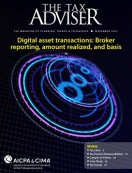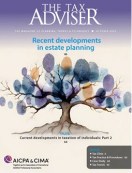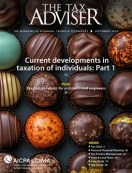- newsletter
- TAX INSIDER

Opportunity zone managers and investors must act before year-end
Find out what taxpayers who established qualified opportunity zones in 2019 must do by Dec. 31, 2019.
Please note: This item is from our archives and was published in 2019. It is provided for historical reference. The content may be out of date and links may no longer function.
Related
IRS clarifies health savings account changes in H.R. 1 in new notice
Government withdraws defense of retirement fiduciary rule
IRS outlines details for Trump accounts
The federal qualified opportunity zone (QOZ) program was enacted as part of the law known as the Tax Cuts and Jobs Act (TCJA), P.L. 115-97, to spur economic development and job creation in 8,700 distressed communities throughout the country and in U.S. territories. Money is pouring into funds nationally, and Dec. 31 will see another massive influx into qualified opportunity funds (QOFs) since that is the deadline to maximize the 15% “step-up” in tax basis after holding a QOF for at least seven years.
The formation of the QOF, which is the required depository of taxpayers’ capital gains, is a fairly straightforward process. However, now that hundreds, if not thousands, of QOFs have been formed, the QOZ program’s complexities begin to surface and will generally require year-end action on the part of the fund managers.
In summary, the QOZ program allows taxpayers to diversify out of one asset class, such as real estate, stocks, a private business, collectibles, cryptocurrency, etc., and defer their federal (and most states’) capital gain tax until 2026 and potentially obtain a full tax exemption on post-reinvestment appreciation by making an appropriate investment into a QOF within 180 days of recognizing a short-term or long-term capital gain. For detailed information on what defines a QOF, which gains are eligible and the types of qualifying OZ investments, please see the information at this link.
A QOF is an investment vehicle formed as a corporation or a partnership that is established with the primary purpose of investing in qualified opportunity zone property (QOZP). Once formed, the QOF must self-certify on IRS Form 8996, Qualified Opportunity Fund, by the extended filing deadline for the QOF in the subsequent year. Care must be exercised to elect a certification date prior to the first date eligible capital gain deferral is invested into the QOF — otherwise some of the investments may not qualify for the QOZ program benefits. Once the QOF is formed and self-certified, there is a semiannual testing requirement to ensure that the QOF is maintaining its qualification requirements.
First-year testing dates
The QOF must first evaluate its asset composition five months after the QOF’s self-certification month (since the month of initial certification is counted as an additional month), or at year-end of the QOF, if earlier. At that point, 90% of the asset cost/value in the QOF on that date must be invested in qualified opportunity zone business property (QOZBP) to avoid penalties. If the QOZBP percentage is less than 90% the shortfall is subject to a floating annualized federal penalty which is currently 5% (.42% monthly).
As an example, if a $2,000,000 QOF only had $1,400,000 (70%) of average QOZBP during a testing period, the $400,000 shortfall (70% vs. 90%) would generate a $10,000 penalty ($400,000 × 5% ÷ 12 × 6 months) for that testing period.
Provided the entity was set up properly (not always the case), virtually all QOFs will meet this first test, since the 2019 proposed regulations (REG-120186-18) allow taxpayers to ignore any fund contributions received in the previous six-month period.
To illustrate an extremely common fact pattern, a QOF formed this year with a self-certified effective date in June 2019 would have a first testing date on Nov. 30, 2019. Assuming it was funded with $2 million during the first six months, 100% of the funds will be treated as QOZBP under the 2019 proposed regulations.
The second testing period for the year of formation will always be the end of the QOF’s tax year — in most cases Dec. 31.
To continue the prior illustration, the QOF formed in 2019 will then have a rapid-fire second test on Dec. 31. If the $2 million was funded all in June, the QOF cannot ignore those amounts on the Dec. 31 testing date since they are beyond the six-month period otherwise excluded in the Proposed Regulations. QOF’s with pre-July 2019 funding will generally need to make some year-end moves to avoid a December penalty — discussed below.
However, if the amount was fully funded in July or later, the QOF will also automatically pass the second test as a result of the six-month funding exclusion.
Taxpayers who certified their QOF after June 30, 2019, will only have one testing date in 2019 — generally on Dec. 31, 2019. And under the proposed regulations, funding contributions during that six-month period will automatically qualify as QOZBP, resulting in automatic passage of the 90% test.
The testing procedures are documented on IRS Form 8996, the same form used for electing the initial self-certification effective date. That form must be completed and attached to the corporate or partnership QOF tax return filed in the subsequent year. On Oct. 31, 2019 the IRS updated Form 8996 to include additional reporting requirements with additional investment transparency as a goal.
Year-end action: Establish a QOZB subsidiary.
The most pressing action item for QOF managers that have not yet invested at least 90% of their funds into QOZBP by the sixth month following initial self-certification (the case with virtually every fund) is to form a subsidiary entity — a qualified opportunity zone business (QOZB), which must also be a corporation or a partnership — no single-member limited liability companies (SMLLCs) are generally allowed at this level.
By forming the QOZB by the sixth month following self-certification and dropping 90% of the QOF’s property and cash down into the QOZB, two very important benefits for investors and the fund managers occur:
- The required QOZBP percentage falls from 90% to 70% at the subsidiary level, and
- The fund can avail itself to the liberal working capital safe harbor rule from the proposed regulations, which allows at least a 31-month period in which to deploy cash into a real estate and/or operating business venture (the taxpayer must have a written business plan and cash-flow projections to qualify under this safe harbor).
Note: The vast majority of QOF/QOZB structures are two-tiered LLC/partnership structures, although corporation/real estate investment trust structures are not uncommon for large real estate projects.
Subsequent year testing
Things get a little more straightforward in the second year. All calendar year QOFs formed in 2019 will be tested on the same semiannual dates in tax year 2020 and future years — June 30 and Dec. 31.
Final regulations have been drafted and are in the final review stage within Treasury. The authors expect them to be published within the next 30 days (probably not until next year), which should provide investors further confidence in OZ investing. Until then, taxpayers are still wise to park money into their own QOF to start the deferral and permanent tax savings benefits.
Blake Christian, CPA, MBT is a tax partner in HCVT LLP’s Long Beach, Calif., and Park City, Utah offices. Alejandra Lopez, MBT, is a tax manager in HCVT’s Long Beach office. The authors have assisted over 25 clients in establishing QOFs and are frequent speakers and authors on the subject. For comments on this article or suggestions of other topics, contact senior editor, Sally Schreiber at Sally.Schrieber@aicpa-cima.com.














